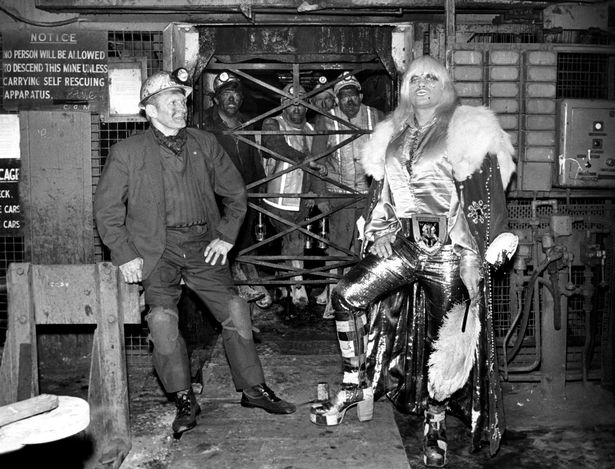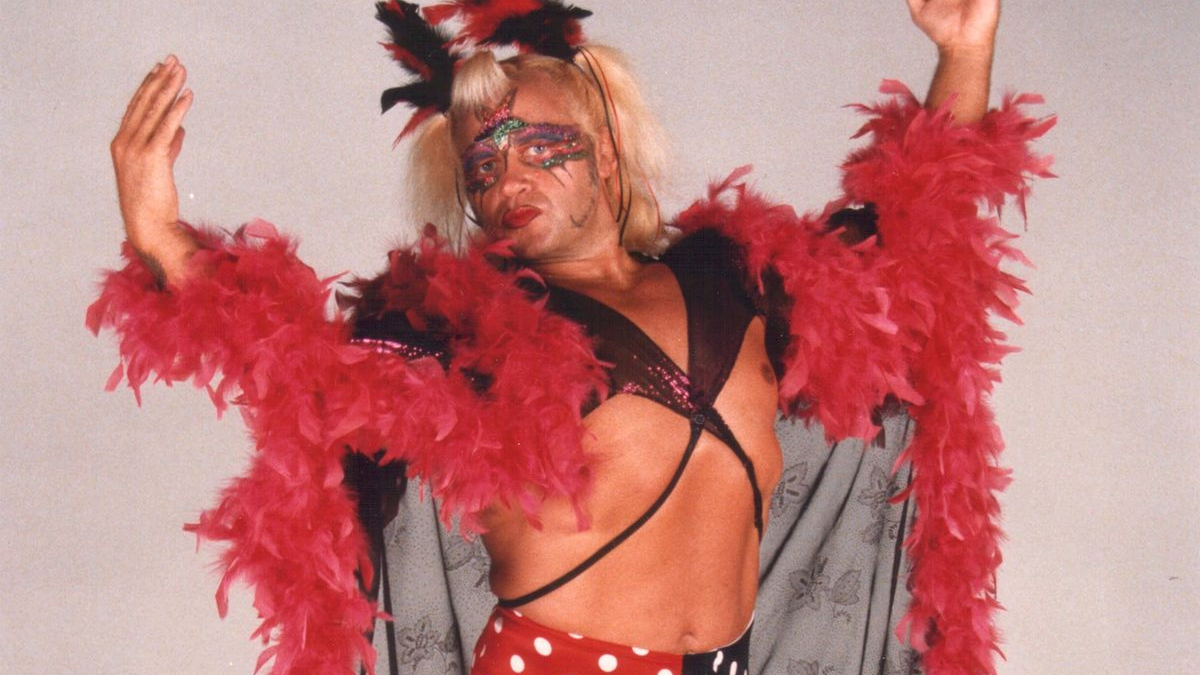“Exotic” Adrian Street, one of pro wrestling’s greatest characters, has died. He was 82.
Family confirmed his passing to the BBC on Monday, July 31. According to the BBC, Street died at Cwmbran’s Grange University Hospital, shortly after brain surgery.
It’s one last headlining run. As Max Crabtree said in Simon Garfield’s excellent oral history of British wrestling, The Wrestling: “Adrian would do anything for attention. He would have shown his private parts on television if he thought it would have done him some good.”
Born in Brynmawr, South Wales, on December 5, 1940, Street left school at the age of 15, heading off to London to try to become a wrestler and avoid working in a coal mine like his father. Instead, he struggled to get by, working in a factory, sweeping up Wembley Stadium and sleeping on park benches when he couldn’t pay for a room. A bodybuilder from the age of 11, his dream of bulking up to 200 pounds to be a wrestler wasn’t compatible with his meager diet, and he actually lost 30 pounds. Desperate, he found himself boxing in a touring carnival for a pound per bout.

Adrian Street returned to the mines where his father Emrys worked to show off his own work clothes. Photo: Adrian Street
At the local gym, he’d pulled around with the cauliflower-eared veterans of the British mat wars, and unable to break onto the main Dale Martin’s circuit, he took whatever bouts he could, debuting in 1957 as Kid Jonathan. Within a couple of years, he was invited to bigger venues, and started working under his real name as “Nature Boy” Adrian Street. But success didn’t truly find Street until he found his image.
Emerging from the dressing room, Street would pause just outside the doorway, allowing the commoners in attendance to take in his long, blond hair, elaborate outfit and garish facial make-up, complete with embedded sequins and rhinestones. “I’d go in the ring looking like a French poodle, and I’d carry on like a French poodle, but as soon as the bell went and I’d done my little bit of prancing about, and the time was right, I’d turn from a French poodle to a pit bull,” Street said.
Playing up an unmanly character was a challenge, but Street always knew what he wanted to portray. Interviewers would hone in on his sexuality, but “The Exotic One” would answer ambiguously. “Whenever someone infers that I’m effeminate, it makes me want to scream.” Over the years, various characters like Goldust (Dustin Rhodes) and Rico Costantino used Street’s gimmick. In Rico’s case, he actually went to study from the master.
In 1969, Street met Linda Gunthorpe Hawker, who would later become woman wrestler Blackfoot Sioux, and later his valet, Miss Linda. Linda added a different dimension and added more mystery. She would allow him to step on her back on the way into the ring, straighten the robe of her “perfectionist pansy,” and occasionally interfere by pulling a leg or bringing out a foreign object. “She was eye candy for the guys in the audience. She also played in and played up on his foibles for the stuff that he needed,” said Lance Russell. “It’s like the Gorgeous George perfuming the corners, and that kind of stuff. That’s kind of what she did. … straighten out his robes and stuff like that. It was designed to pique the irritation point of the crowd, because here was this perfectionist pansy.”
Adrian and Linda set off for the North American market in 1981, beginning in Calgary, then Mexico and Los Angeles before finding a real home in the southeastern U.S. Promoters and bookers didn’t always know what to do with him. As the booker in Florida for a time, Bob Roop admitted he didn’t understand the gimmick. “I didn’t feel like the kind of solid, long-term heat that you needed to draw with as a bad guy, I didn’t feel that type of gimmick could carry it. That might have been my limitations as a booker.”
Street has no problem explaining what he nuances of what he was trying to achieve. “My idea of a bad guy is possibly different than a good many others. To me there’s no reason why a bad guy’s got to get cheap heat all the time, where he’s got to growl and scream at everybody, jump in the ring, poke somebody in the eye, kick them in the balls as the first move, and scream and shout until his eyeballs pop out. My own way of doing it was to go into the ring and wrestle, and show the people what a good wrestler I was,” he said.
Rip Rogers was the heel in a year-long feud with Street in the Florida, Alabama, Mississippi area. “You had to go with the flow with Adrian. Me and Adrian never talked over a match,” Rogers said. “All that mattered was the finish, and what we were coming back with. The rest was ad lib out there. No prearranged bullshit like they there is today.” Terry Taylor was the good-looking babyface working with Street in the Mid-Atlantic territory. “Adrian was a guy who looked like couldn’t bust a grape, and in real like was probably one of the toughest wrestlers around,” he said, explaining the problems working with Street’s style. “It was very difficult, it was very awkward, different timing, different execution of moves. In the old days, when we prided ourselves on having good matches with anybody, and Adrian was the kind of guy that, if I had a match with Kamala one night, he was limited by what his character would let him do, and Adrian was limited, honestly, by what he could do. But he knew exactly who Adrian Street was.”
UK historian Bradley Craig noted that Street was “totally fearless” in the 1970s. “When he was on a card, he would sometimes promote the shows on the high street of the town, dressed in his full regalia. Given the tolerances of the time, it showed that Adrian was willing to put his life on the line for a packed house. But he also knew how to take care of himself, so it’s likely that anyone who picked a fight with him would end up sorry that they did,” said Craig. “One of the most creative title matches I ever learned about was Adrian’s war with Bill Ross, for the middleweight championship in Aberdeen. Moments before the match, Street revealed that he had come in overweight for the bout, so the title fight couldn’t occur. It meant that the crowd were furious and wanted blood. But they also returned in droves when Street was forced to return for a rematch, where he would be stripped of the title if he didn’t make weight.”
There needs to be acknowledgment on Street’s role in popularizing wrestling merchandise too. He record an LP, complete with a poster that folded out. Later it was a series of autobiographies (My Pink Gas Mask; I Only Laugh When It Hurts; So Many Ways To Hurt You; Sadist in Sequins; Imagine What I Could Do To You; Violence is Golden; Merchant of Menace), T-shirts, and more.
Adrian Street Shake Wrestle ‘N’ Roll album from 1986.
But back to the record. At one point, he was wrestling in Liverpool Stadium — a rough place, the type of arena where the wrestlers had to fight their way to the ring — against Joe Cortez. Street and Cortez decided to try something new. After parading to the ring in one of his fancy-dan outfits, Street saw that Cortez had a copy of his record. Though he tried to never acknowledge his opponent before a match, Adrian gave him a nod of approval for his obvious good taste.
“Next thing is, he starts to rip up the poster into pieces and throws it all over the place,” Street explained. “He gets a hold of the record, and breaks it over his knee, smashes it up and throws it to the people. I’m screaming and shouting, going nuts. Jon says to somebody, ‘Get me another record.’ The people were running and lining up in bloody hundreds to grab the record and bring it down to Jon. They were bringing them down, and he was breaking them up, showing me the poster, breaking them up. I made more money than night than I had wrestling in about six months on the records, just to break the damn things up. Now I couldn’t care less what they did with them. I was just interested in the money and getting rid of the bloody things.”
In all, Street released three albums: Naughty But It’s Nice, Shake Wrestle ‘N’ Roll (on Burger Records in 1986, the best known of his albums), and Naughty But Nice.
It was key to one of Street’s philosophies on the business. “You’ve got to give the people a chance to react to what you’re doing, and give the people a chance to perform,” he said. “The only difference between the wrestler and the people is that the wrestler is paid to perform and the people pay to perform.”
By the late ’80s, Street had settled in the Gulf Coast region, where he lived for many years. He and Linda made a living primarily by making custom-made ring attire through their old bizarebazzar.com website. Street has taught wrestling as well at his Skull Crushers Wrestling School, which blew away during a hurricane in the early 2000s. Street battled off throat cancer in 2001. In The Pro Wrestling Hall of Fame: The Heels, Street said that retirement was not an option. “I can’t do nothing. I’m not intelligent enough to do nothing.”
Drew McIntrye and Adrian Street. Twitter photo
He returned to living in Wales in recent years, and made an appearance at the WWE Clash at the Castle special in Cardiff in September 2022.
Street’s last Facebook post, on July 22, shared an update on his surgery: “After several more weeks in various hospitals for both heart & Brain surgery, I am back home – lets hope I manage to stay- if I’m lucky – its all due to my lovely Wife Linda xxxxxxxxx I LOVE YOU VERY MUCH XXXXXXXXX”
— with files from Steve Johnson
RELATED LINKS
